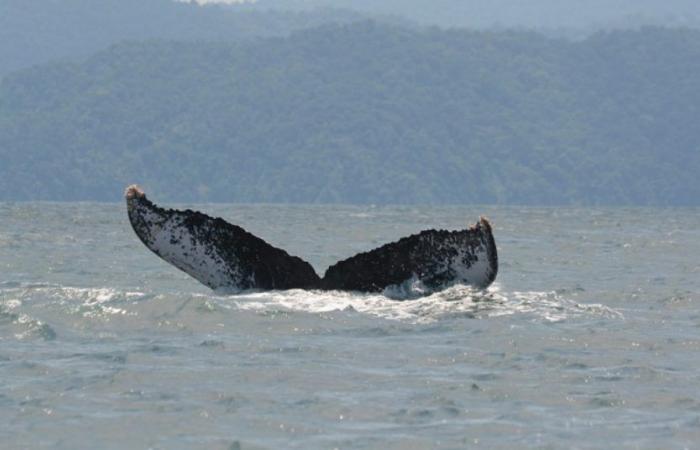Colombian scientists analyzed hundreds of hours of underwater sound recordings and detected that whales choose to sing when there is less noise from fishing boats. Cetaceans use songs to search for each other, communicate and mate.
A new study documented the soundscape of the Pacific Ocean in the Colombian Chocó and revealed a wide wealth of sounds, among which the songs of humpback whales.
However, the scientists also warned that this acoustic diversity decreases with age. human activity. This finding allows us to conclude that The habits of the species that live or roam this area of the Pacific could be altered if the construction of the Tribugá port is completed, a proposal that, although it was discarded in 2020, could be revived, experts say.
The investigation was carried out by a group of Colombian and American scientists who collected sea sounds of the area, between 2018 and 2019, like those of the Humpback whales (Megaptera novaeangliae), fish, shrimp, as well as from small boats and the environment, including rain or wind. The research was published in the scientific journal The effects of noise on aquatic lifein early 2024.
Whales and songs
Compared to other regions of the world, the Tribugá Sea, in the Colombian Pacific, is quite calm and has little human noise pollution. That was what the scientists concluded after analyzing the recordings made over a year. But the main finding was more interesting: Whales change their behavior depending on human activity.
The researcher at the Javeriano Water Institute and co-author of the study, María Paula Rey, explains that whales use their song to communicateestablish dominance, mate or search for other whales.
In other parts of the world such as Mexico and Hawaii, the scientist says, it is normal for whales sing at midnight, but in Morro Mico, one of the two places that the scientists analyzed, the males are singing in the mornings. A possible explanation for this difference, the researchers point out, is that they are “choosing to sing when there is not as much noise of fishing boats”, since these operate mainly at night.
In Nuquí, the second study site and an important tourist focus of whale watching, mammals sang more at night. There, unlike Morro Mico, human activity is highest during the day.
To record the whales, scientists used recorders or microphones advanced that are located at the bottom of the sea and that resist water. They are known as hydrophones and “they are microphones that can be submerged in the ocean and programmed to record for certain periods of time continuously,” says Rey.
A total of 445 hours of recording on 261 different days, for a total of 12,655 recordings of approximately 10 minutes each. The researchers then listened to each of those recordings to detect the whale songs and other sounds and classify them. Subsequently, the scientific They statistically analyzed the database created to determine trends.
Rey adds that the alliance of PHySIC project organizations (which in English means Ports, Humpbasck and Sound in Colombia) was key to making the research possible. The leadership of the Macuáticos Foundation was also fundamental Colombia which has been in business for more than 11 years Scientific work and of conservation in the area, so he knows the dynamics of the territory and has developed collective projects with the Chocó community.
Science has already detected before that noise has impacts on whales and other species since it generates dazeneed to get away or stress. “Noise can generate stress and affect developmental, immune or reproductive functions,” assures Rey who adds that, in addition, due to the noise or presence of boats, humpback whales change the swimming speed and direction. In fact, during the tourist season in Colombia’s Chocó, which begins in August with the arrival of humpback whales at that time of year, boats must maintain a necessary distance of 100 meters.
Natalia Botero, PhD in Animal Behavior from the University of Southern Mississippi (USA) and director of the Macuáticos Colombia Foundation, is an expert in detecting levels of cortisolthe stress hormone, in whales. Botero assures that it is important to protect the singing ability of whales in Chocó, since it is in this area that humpbacks live. they reproduce and the male, who is the one who sings, must be able to communicate for this to be possible.
For study co-author Kerri Seger, a doctor in Biological Oceanography at the University of California in San Diego and leader of PHySIC, the ‘masking’ effect produced by noise pollution is worrying. Seger refers to when whales have to compete in volume with the noise of the boats so that their offspring or peers can hear them.
“It’s like if you were at a rock concert, how long can you scream until you lose your voice?” says Seger, adding that “we don’t know how long.” Additional stress adds screaming louder, or if it costs more calories, or if the animals will eventually just give up on communication altogether and leave the area.” Another way, she adds, would be to wait for silence, but What happens when there are too many boats that won’t shut up? According to the expert, stress can even cause immune problems in whales.
Off the west coast of the United States, some whales have chosen to dive deeper to avoid noise, says Seger, but this has had fatal consequences. “There are anecdotes in the Santa Barbara channel that the blue whales “They go underwater, but they come up to breathe right in front of a tanker, they are hit and they die.” Although it is normal for whales to detect boats, he says, an excess of boats can cause the animals to become disoriented. For this reason, researchers are concerned about the possibility of an industrial port being built in Colombia’s Chocó.
underwater sounds
Although in 2020, the National Infrastructure Agency rejected the progress of the project that sought to build a industrial port in Tribugáthe company indicated that it was determined to continue with the project.
Here it would be necessary to say what it is about, where it is, what it would be used for, how many ships it would receive, the reasons why it was rejected.
Although the mega-work has been discarded for now, there are reasons to think that it could be resumed. One of them is the progress of the construction of the Las Ánimas – Nuquí road, which will connect the area of Tribugá to the rest of the country and that could receive more national investment, according to statements by the governor of the crashedNubia Carolina Córdoba Curí.
According to Botero, the road would be an incentive for the port work to be resumed, which has not been ruled out by the environmental authorities. “One of the big operational buts to the project is that there was no connection of this area with the rest of the country, that will be provided by the via Las Animas – Nuquí, which can make the port project gain strength again.” He also says that the road will generate deforestation by affecting the Serranía del Baudó, a forest that has little impact and could encourage the arrival of human settlements and wildlife trafficking.
The port would represent “a very severe and harmful change for that sound environment that is the Gulf of Tribugá and the Colombian Pacific. It would be going from a sustainable use to an industrial one,” says Botero. Furthermore, Seger adds that industrial navigation would cause the whales to dive further, which would impact local whale watching tourism.
Whether they are needed or not restrictive protected areaslike a national park, to protect the whales of a possible port, the scientists consider that they can be of help, but only if they have constant monitoring by the State and civil society. “I think it is really a question of society and how much people value protected areas and how much They will respect the laws and regulations implemented,” says Seger.
Furthermore, Botero assures, currently the area already has the figure of protected area cataloged as an Integrated Management and Tribugá District and is also a buffer zone of the Utría National Natural Park, as well as Biosphere Reserve from UNESCO from 2022.
“The protection figures already exist, rather than creating another one, it is about continuing to conserve the area. Protected areas do not necessarily guarantee conservation because institutions do not have sufficient management capabilities. control and monitoring. The management capacities that the communities have already demonstrated must also be strengthened,” says Botero.
Photo: Natalia Botero / Macuáticos Colombia Foundation.
This is an original note from Mongabay Latam, published in partnership with El Desconcierto.






